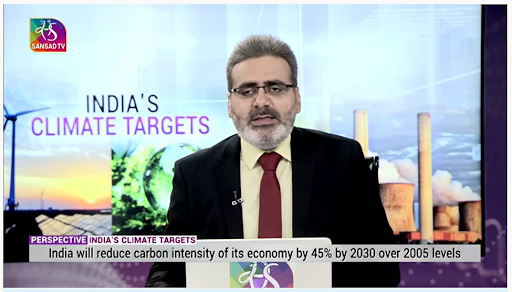In the series Sansad TV Perspective, we bring you an analysis of the discussion featured on the insightful programme ‘Perspective’ on Sansad TV, on various important topics affecting India and also the world. This analysis will help you immensely for the IAS exam, especially the mains exam, where a well-rounded understanding of topics is a prerequisite for writing answers that fetch good marks.
In this article, we feature the discussion on the topic: India’s Climate Targets

Anchor: Vishal Dahiya
Guests:
- Urmi Goswami, Senior Journalist
- Prof. C. K. Varshney, Environmentalist & Former Dean, School of Environmental Sciences, JNU
- Dr. Vaibhav Chaturvedi, Policy Expert, Council on Energy, Environment & Water, CEEW
Context: The Union Cabinet has approved India’s updated Nationally Determined Contribution to be communicated to the United Nations Framework Convention on Climate Change.
Highlights of the Discussion:
- Meaning of this target update in the larger framework of Climate change goals.
- How ambitious was India in setting and updating these goals
- Are these NDC targets aggressive enough to address the Climate challenges we are facing today.
- How other countries are responding to climate change
- What more we can do to achieve these targets effectively- the road ahead.
Introduction:
- India’s updated climate pledge to the Paris Agreement received the Union Cabinet’s nod on August 3, 2022.
- The updated NDC seeks to enhance India’s contributions towards the strengthening of global response to the threat of climate change, as agreed under the Paris Agreement.
- The country submitted its first pledge in 2015. As per the Paris Agreement’s provisions, countries must ‘update’ their pledges every five years to make higher commitments to greenhouse gas (GHG) emissions reductions.
- This update translates the ‘Panchamrit’ or five-point agenda announced by PM Modi at COP26 into enhanced climate targets.

Image Credit: Down to Earth
Read more on Intended Nationally Determined Contributions and Updated NDC
Analysis of enhanced NDC:
- Updated NDC will help India bring in low emissions growth avenues and safeguards the interests of India and protect its future development needs based on the principles and provisions of the UNFCCC.
- This also seeks to improve India’s contributions towards the strengthening of global response to the threat of climate change.
Feasibility of achieving these targets:
- Rapid progression in recent years with respect to solar, wind and other renewable energy policies pushed the government to go for ambitious targets.
- India will be achieving 30-33% reduction in emission by 2026 much ahead of the targeted time and India’s non-fossil fuel installed capacity is already at 41.1% by June 2022.
- Various green shoots on reducing fossil fuel usage are also progressing forward which gives confidence on achieving these targets . For Example: Amended National Policy on Biofuels has advanced the ethanol blending target of 20% blending of ethanol in petrol to the year 2025-26 from 2030.
- New transport policy, better road infrastructure resulting in fast movement of people and cargo reduces consumption of fossil fuels.
- Successful combination of all these policies are helping India to achieve the aggressive figures of updated NDC.
- Updated NDC is very much achievable and sets the stage for other international players to come forward and give more aggressive NDCs.
- As NDC needs to be updated every 5 years, there is always room for more aggressive goals with more stability in the global economy.
Possible Roadblocks:
- Global macroeconomic scenario is dull with inflation and recession clouds due to various geopolitical reasons.
- In reality, we have to be cognizant of these big shifts in global macro economic order as they have extremely important implications on global energy demand.
- Real estimates on Carbon sink is lacking and increased frequencies of heat waves creates more wildfires which inturn reduces the plant productivity and soil moisture comes down with it, under these stressful conditions carbon sequestration capacity is going to be affected which alters carbon sink in total.
- Other countries have not yet submitted the revised NDC, especially developed countries who have made promises without any roadmaps.
Way Forward:
- For India, that needs to grow economically with a target of 5 trillion USD economy in a climate constrained world is a challenge.
- To sustain the growth and improve the well-being of the public, India needs to achieve these targets as we are in the middle of a triple environmental crisis that is, Climate Change, Biodiversity loss and Pollution.
- India, with so many policies on the horizon has to take a leadership role and steer the action against climate change.
Conclusion:
India has no time to be complacent on its achievements and progress in NDC as our energy needs are going to grow. Global warming is an international issue and it should be the duty of developing countries to augment their capacities and developed countries to provide the necessary funding. There should be a concrete and clear roadmap involving all stakeholders to start our efforts towards achieving NDC.
Sansad TV Perspective: India’s Climate Targets:- Download PDF Here
Read all the previous Sansad TV Perspective articles in the link.
| Related Links | |||
| Causes Of Climate Change [Geography Notes For UPSC] | Climate, Vegetation & Wildlife of India | ||
| Koppen Climate Classification [Geography Notes For UPSC] | G20 | ||
| ASEAN | BIMSTEC | ||
Comments